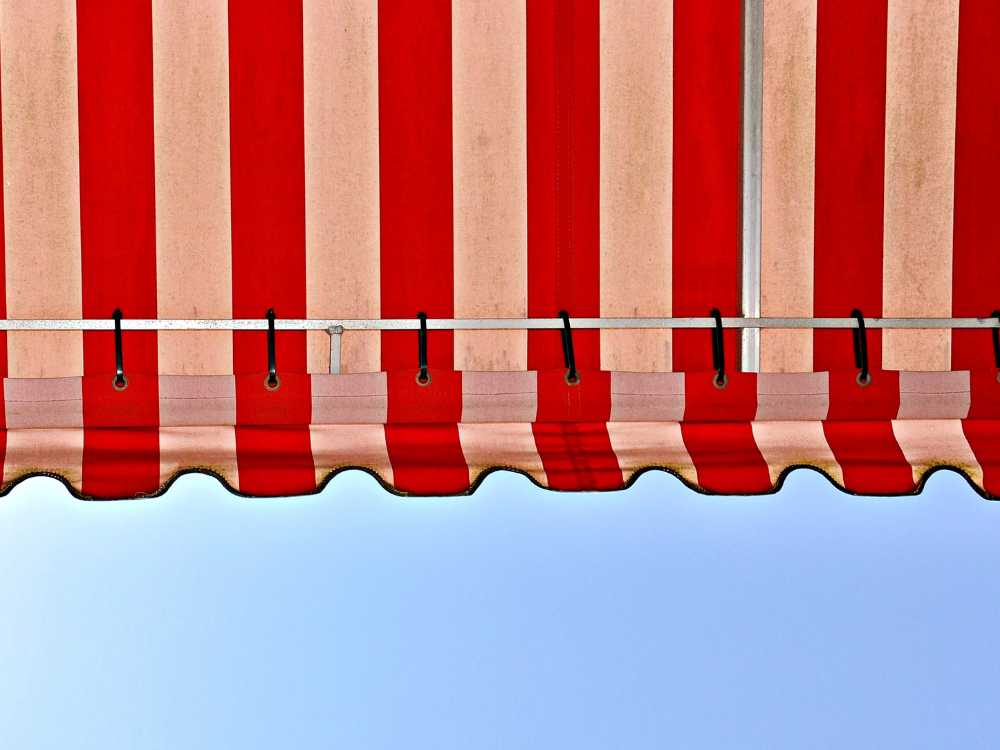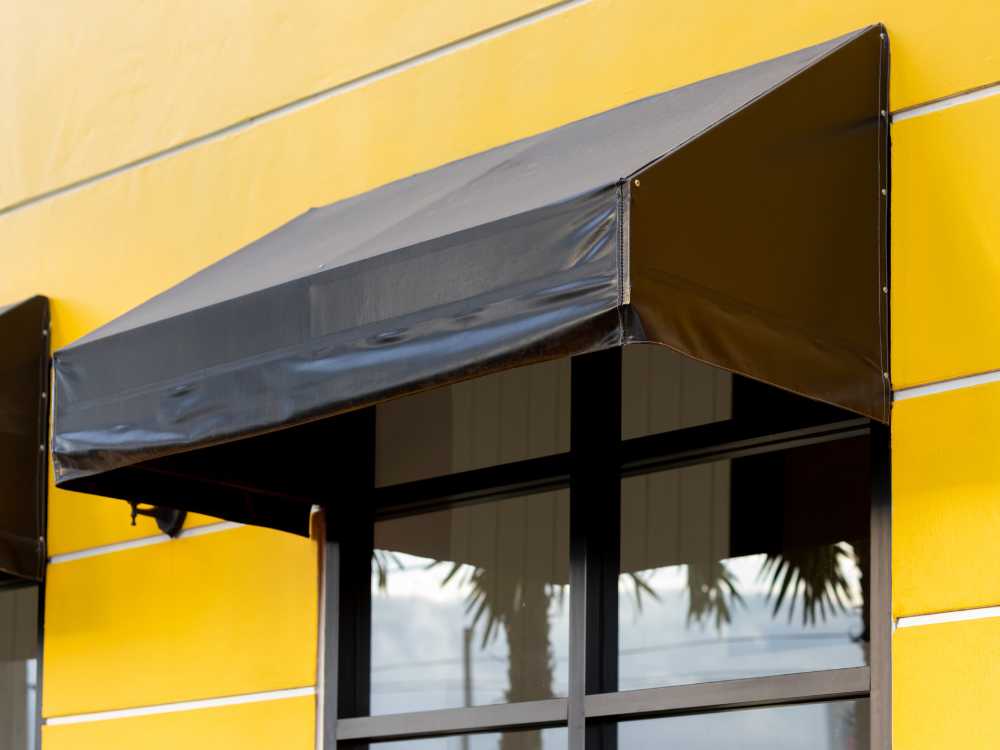Canvas awnings add shade, comfort, and style to outdoor spaces, but they can also become a target for mold, especially in damp or humid weather. Mold not only makes awnings look dirty and worn out, but it can also lead to health concerns if left untreated. In particular, black mold is a type of fungus that can trigger reactions in the immune system, making it important to deal with the problem quickly. Regular cleaning and a few simple steps can keep awnings looking fresh, strong, and safe.
Table of Contents
Key Takeaways
How to Clean Mold off Canvas Awnings
Preparation Before Cleaning
Cleaning Solution Options
Step-by-Step Cleaning Process
Drying the Awning
Preventing Future Mold Growth
Frequently Asked Questions
Choose Quality Canvas Awnings in Connecticut with Durkin’s!
| Key Takeaways ✔ Proper preparation removes dirt and sets the canvas awning up for a more effective mold cleaning. ✔ Choosing the right cleaning solution makes it easier to treat both light and stubborn mold spots. ✔ Following a simple step-by-step process ensures mold is scrubbed away without damaging the fabric. ✔ Allowing the awning to dry fully in the sun prevents dampness that can cause mold to return. ✔ Consistent upkeep and protective measures stop mold from growing back and keep the awning fresh longer. |
While this article walks you through DIY steps to clean mold from canvas awnings, remember that Durkin’s also offers professional cleaning, maintenance, and seasonal storage services across Connecticut—so you’re never on your own if it becomes overwhelming!
Here are some easy tips to get rid of mold and keep canvas awnings clean for the long run.
How to Clean Mold off Canvas Awnings
Preparation Before Cleaning
Before starting the process of how to clean mold off canvas awnings, it is important to get the awning ready. Proper preparation makes the actual cleaning easier and helps the cleaning solution work better.
Remove Loose Dirt and Debris
The first step is to clear away anything sitting on the awning surface. This keeps dirt from mixing with the cleaner and spreading stains.
- Soft Brush: A soft-bristle brush is gentle enough not to damage the fabric but strong enough to sweep away dust, dried leaves, or bird droppings. Using the right brush prevents the surface from fraying and keeps the fabric looking neat. It also helps the cleaning product soak into the material more effectively.
- Focused Sweeping: Work from the top of the awning down to avoid pushing dirt into areas that are already clean. Starting at the top ensures debris does not slide back onto freshly brushed sections. This simple habit saves time and reduces the need for repeated cleaning.
- Consistency: Brushing off the awning regularly can reduce how much mold builds up over time. Regular upkeep prevents moisture and organic matter from sticking, which mold feeds on. Over time, it also extends the life of the fabric and keeps the awning looking bright.
Fully Extend the Awning
Making sure the awning is completely open allows for a thorough and even cleaning.
- Extended Coverage: A fully opened awning gives access to all fabric areas, including corners where mold often hides. This makes it easier to spot problem spots and apply the cleaner evenly. In the long run, it prevents hidden patches of mold from spreading across the fabric.
- Stability: Securing the awning in place keeps it steady while scrubbing or rinsing. Movement during cleaning can cause streaks or missed areas, so keeping it fixed is important. A steady awning also makes the job safer and more comfortable.
- Safety: Cleaning in an extended position reduces the risk of missing mold patches, which is especially important when figuring out how to clean an awning with mold. Being able to see the entire surface also avoids leaving damp, untreated areas behind. That extra step lowers the chances of mold returning quickly.
Work in a Ventilated Space
Good airflow is necessary when using any cleaner for canvas awnings, whether it is a homemade solution or a store-bought option.
- Air Circulation: Open spaces help cleaning products dry faster, preventing new mold from forming. Quick drying also reduces the risk of fabric weakening from sitting in damp conditions. With better air movement, the cleaning process feels less overwhelming.
- Comfort: Fresh air reduces strong odors from solutions, making the task easier to handle. Some cleaning products, even natural ones, can have strong smells that linger. A breeze ensures the space feels comfortable and safe to work in.
- Sunlight Advantage: Sun exposure helps naturally disinfect and supports drying after applying the best canvas awning cleaner. Sunlight can kill off small traces of mold that cleaning may have missed. It also keeps the canvas bright and helps lock in freshness.
Cleaning Solution Options

Cleaning canvas awnings is easier when the right solution is used. Depending on how much mold is present, the choice of cleaner can make a big difference. Knowing how to clean mold off canvas awnings properly helps keep them fresh, safe, and long-lasting.
Mild Soap and Water
For light mold, a gentle mix of soap and water is usually enough. This simple method is often the first step when learning how to clean an awning with mold that has just started to show.
- Easy to Prepare: Mix a few drops of mild dish soap with warm water in a bucket. The ingredients are easy to find in most households, making it convenient for quick cleaning. Because the mixture is not harsh, it can be applied safely without protective gear.
- Safe For Fabric: This gentle solution won’t damage the canvas while lifting surface dirt and light mold spots. The fabric keeps its color and strength because there are no harsh chemicals involved. It also reduces the risk of wear and tear caused by stronger cleaners.
- Good for Quick Cleanups: Best used when mold hasn’t spread much and only small patches are visible. Soap and water are simple enough for routine maintenance between deeper cleans. It helps extend the life of the awning by preventing mold from spreading further.
Vinegar Solution
When mold is a bit tougher, vinegar works well as a natural and safe cleaner for canvas awnings. It is especially useful for those who want a non-chemical approach.
- Natural Mold Fighter: White vinegar is an affordable and safe way to fight mold thanks to its antifungal and antibacterial properties. With 5 to 8 percent acetic acid, it disrupts mold growth while being safer for pets and plants than chemical sprays.
- Easy To Use: Spray undiluted vinegar directly onto the affected areas and let it sit for about 15 minutes. The soaking time allows the vinegar to loosen mold and dirt before scrubbing. Many homeowners appreciate this method because it requires little effort and no mixing.
- Rinse and Dry: After soaking, rinse well with clean water and let the awning dry completely in the sun. Rinsing ensures no vinegar smell lingers on the fabric. Sunlight adds an extra layer of protection since natural UV rays can help kill remaining spores.
Specialized Mold Cleaner
For stubborn mold that doesn’t come off with basic solutions, using the best canvas awning cleaner is the most effective option. These products are made to handle heavy mold buildup without harming the fabric.
- Designed For Canvas: They contain ingredients that target mold while being safe for awning material. The formulas are tested specifically for outdoor fabrics, giving reliable results. Many brands even recommend them as the top choice when learning how to clean mold off canvas awnings.
- Strong And Effective: Perfect for deep cleaning when home remedies are not enough. These cleaners are able to penetrate the fabric and remove mold stains that soap and vinegar leave behind. They also save time because fewer applications are needed compared to lighter solutions.
- Long-Lasting Results: Some cleaners add a protective layer to help prevent mold from returning. This extra shield makes maintenance easier because mold takes longer to grow back. It also ensures that the awning keeps its clean look for a longer period between washes.
Step-by-Step Cleaning Process
Cleaning mold from canvas awnings does not need to be complicated. With the right approach, even beginners can follow simple steps and restore their awnings to a fresh, mold-free look. For those wondering how to clean mold off canvas awnings, this section breaks the process into clear stages.
If DIY isn’t your style—or if the mold is extensive—Durkin’s full-service maintenance includes a thorough cleaning, inspection, and even replacement covers if needed, so your awning looks like new come spring.
Apply the Cleaning Solution
It is important to use the right solution when starting the cleaning process. Choosing the best canvas awning cleaner or even a mild soap mix makes the task easier. A sponge or a soft brush should be used to avoid damaging the canvas.
- Gentle Application: Lightly scrub the affected area in circular motions to loosen the mold. The goal is to lift the growth without harming the fibers of the fabric. This method helps the cleaner soak in evenly and reach deeper spots of mold.
- Avoid Harsh Pressure: Too much force can wear down the fabric, so it is best to keep movements soft and steady. Pressing too hard can create weak spots or even small tears in the canvas. Using gentle strokes protects the awning while still cleaning effectively.
Allow the Solution to Sit
After applying the cleaner, the next step is letting it work on the surface. This helps break down mold stains and makes removal easier.
- Short Waiting Time: Leave the solution on for a few minutes but not long enough to dry completely. If it dries, the cleaner may leave behind marks or film. Keeping an eye on the surface ensures the solution works properly.
- Even Coverage: Make sure all mold spots are properly soaked with the solution to ensure effectiveness. Covering the full area helps prevent the mold from spreading back. By treating every part, the canvas stays evenly clean.
Rinse Thoroughly With Clean Water
Once the solution has done its job, rinsing is essential. This step prevents leftover soap or cleaning agents from weakening the canvas. Knowing how to clean an awning with mold includes proper rinsing to keep it in good condition.
- Use Fresh Water: Spray or pour clean water over the treated spots until all residue is gone. Any leftover cleaner can attract dirt and cause discoloration over time. A full rinse keeps the canvas fresh and safe.
- Check for Leftovers: Look closely to make sure no cleaner remains, as this could attract more dirt later. Inspecting carefully helps avoid streaks or patchy spots. This small step makes the final result look smooth and even.
Repeat If the Mold Is Stubborn
Sometimes, mold does not come off in just one try. Using a reliable cleaner for canvas awnings more than once can solve this problem.
- Reapply as Needed: Put the cleaning solution back on any remaining mold patches. Some areas may need a second or third treatment to fully fade. Taking time to repeat the process ensures long-term results.
- Be Patient: Tough stains may need two or three cycles, but repeated gentle cleaning will eventually remove them. Rushing the process can damage the canvas or leave spots behind. A steady approach keeps the awning both clean and intact.
Drying the Awning

After cleaning, it is important to let the awning dry fully. A damp awning can easily attract mold again, which makes the cleaning effort useless. Taking the right drying steps will help keep the awning fresh and long-lasting.
Air Dry in the Sun
The best way to dry canvas is by letting it stay open and exposed to natural sunlight. Sunlight helps remove moisture and discourages mold from coming back.
- Quick Drying: The warmth of the sun speeds up the evaporation process, so the fabric dries faster. This makes it easier to prevent water from soaking into the canvas for too long. A quick dry time lowers the chance of mold regrowth.
- Natural Protection: Sunlight contains natural UV rays that act as a mild disinfectant. These rays help reduce the spread of mold spores left behind after cleaning. Keeping the awning under the sun is a safe way to protect the fabric naturally.
Do Not Roll It Up Damp
Rolling up a wet awning traps moisture inside the fabric layers. This creates the perfect spot for mold to grow again.
- Avoid Moisture Build-Up: When an awning is folded while damp, the trapped humidity encourages mold to spread quickly. The dark, enclosed space makes it worse because there is no airflow. Leaving the awning fully extended until dry solves this problem.
- Longer Lifespan: Allowing the awning to dry flat keeps the fabric strong and flexible. Damp storage can weaken stitching and cause early wear. By avoiding this mistake, the awning can last for many more years.
Extra Tips for Mold-Free Care
Along with drying, a few extra habits can keep canvas awnings in good shape. These steps are simple but effective for anyone learning how to clean mold off canvas awnings.
- Use the Best Canvas Awning Cleaner: Choosing a reliable product makes cleaning safer and more effective on tough stains. A good cleaner for canvas awnings removes dirt without damaging the fibers. With the right cleaner, mold spots are easier to remove and prevent.
- Learn How to Clean an Awning With Mold: Knowing the proper method makes the job less stressful and more successful. Clear instructions help prevent damage from scrubbing too hard or using the wrong solution. Following these steps keeps the awning looking fresh for longer.
- Stick to Gentle Products: A mild formula is often the best canvas awning cleaner for regular upkeep. Strong chemicals can weaken the fabric and shorten its life. Using gentle cleaners helps the canvas stay strong while still removing mold.
Preventing Future Mold Growth
Keeping canvas awnings clean is not only about removing mold when it appears, but also about taking steps to stop it from coming back. With the right care, canvas stays fresh, strong, and free of mold for much longer.
Regularly Brush Off Dirt and Leaves
Small amounts of dirt, dust, or leaves may not seem like much, but they create the perfect place for moisture and mold to grow. Regular brushing keeps the surface clear and allows the canvas to dry faster after rain.
- Remove Loose Debris: Use a soft brush or broom to sweep away leaves and dirt before they build up.
- Prevent Moisture Traps: Keeping the awning clear stops wet leaves and dirt from holding in water, which often leads to mold.
Keep Awnings Dry When Possible
Moisture is the main reason mold forms on canvas. By allowing the awning to dry properly, the risk of mold growth drops significantly.
- Open After Rain: If the awning was wet, leave it fully extended so it can dry completely in the sun.
- Avoid Rolling Up Damp Fabric: Rolling the canvas while wet traps moisture inside, which encourages mold.
Use a Protective Canvas Spray for Added Resistance
Canvas sprays provide a protective layer that helps resist water, dirt, and stains. This extra step makes the awning easier to clean and keeps mold from taking hold.
- Water-Repellent Coating: A protective spray helps water roll off instead of soaking into the canvas.
- Longer Lasting Clean: With a spray applied, it becomes much easier to wash the awning using mild solutions like the best canvas awning cleaner.
Frequently Asked Questions (FAQs)
Mold can be removed from waterproof fabric by using a gentle cleaning solution like mild soap and water or a vinegar mixture. Scrub lightly with a soft brush to avoid damaging the waterproof layer. Always rinse thoroughly with clean water and let the fabric dry completely. Avoid harsh chemicals that may strip away the waterproof coating.
Green algae can be scrubbed off canvas with a mix of water and mild detergent or a vinegar solution. Using a soft brush helps lift the algae without harming the fibers. Rinse the canvas well after cleaning to remove residue. Allow it to dry in full sunlight to discourage algae from coming back.
Hydrogen peroxide can be used on canvas in small amounts for spot cleaning, but it should be diluted first. Strong concentrations may weaken or discolor the fabric over time. Always test on a hidden area before applying it broadly. Rinse the canvas well after use to protect its strength.
An awning can be washed, but it should be done carefully by hand rather than in a machine. Use mild soap and water along with a soft brush or sponge to clean dirt and mold. Rinse thoroughly to prevent soap buildup. Let the awning dry fully before rolling or storing.
Black mold is generally worse than mildew because it can cause stronger health reactions and is harder to remove. Mildew usually stays on the surface and is easier to clean away. Black mold can penetrate deeper into fabric and spread more quickly. Both should be cleaned promptly, but black mold requires more attention.
Choose Quality Canvas Awnings in Connecticut with Durkin’s!
Durkin’s is a trusted provider of canvas awnings across Connecticut, offering designs that bring both function and style to homes and businesses. With a long-standing reputation in Connecticut, Durkin’s delivers durable awning solutions built to last while enhancing outdoor spaces. Each installation reflects quality craftsmanship and attention to detail that sets Durkin’s apart as a leading awning provider in Connecticut.
Contact Durkin’s today to explore custom canvas awning options and add lasting value to any property!












